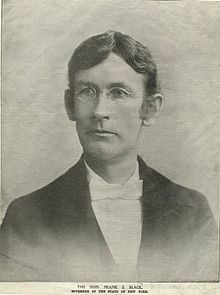
Back فرانك إس. بلاك Arabic فرانك اس. بلاك ARZ فرانک اس. بلک AZB Frank S. Black German فرنک اس. بلک FA Frank S. Black Italian Franciscus Swett Black LA Frank S. Black Swedish
Frank Swett Black | |
|---|---|
 | |
| 32nd Governor of New York | |
| In office January 1, 1897 – December 31, 1898 | |
| Lieutenant | Timothy L. Woodruff |
| Preceded by | Levi P. Morton |
| Succeeded by | Theodore Roosevelt |
| Member of the U.S. House of Representatives from New York's 19th district | |
| In office March 4, 1895 – January 7, 1897 | |
| Preceded by | Charles D. Haines |
| Succeeded by | Aaron Van Schaick Cochrane |
| Personal details | |
| Born | March 8, 1853 near Limington, Maine, U.S. |
| Died | March 22, 1913 (aged 60) Troy, New York, U.S. |
| Resting place | Frank S. Black Farm, Freedom, New Hampshire |
| Political party | Republican |
| Spouse |
Lois B. Hamlin (m. 1879) |
| Children | 1 |
| Education | Dartmouth College (BA) |
| Occupation | Newspaper editor Attorney |
| Signature | |
Frank Swett Black (March 8, 1853 – March 22, 1913) was an American newspaper editor, lawyer and politician. A Republican, he was a member of the United States House of Representatives from 1895 to 1897, and the 32nd governor of New York from 1897 to 1898.
A native of Limington, Maine, Black graduated from Dartmouth College in 1875 and moved to New York, where he edited and reported for newspapers in Johnstown and Troy. He studied law, attained admission to the bar in 1879, and practiced in Troy.
Black became involved in politics by giving speeches for Republican candidates and serving as chairman of the party in Rensselaer County. In 1894, he was a successful candidate for the United States House of Representatives, and he served a partial term, March 1895 to January 1897. Black resigned before the end of his term because he had been elected governor.
In 1896, Black was the successful Republican nominee for governor. He served one term, January 1897 to December 1898. He was an unsuccessful candidate for renomination in 1898, losing at the party's state convention to Theodore Roosevelt, who went on to win the general election.
After leaving office, Black resumed the practice of law and remained active in politics as a campaign speaker for Republican candidates. He died in Troy on March 22, 1913, and was buried at his summer home, a farm in Freedom, New Hampshire.